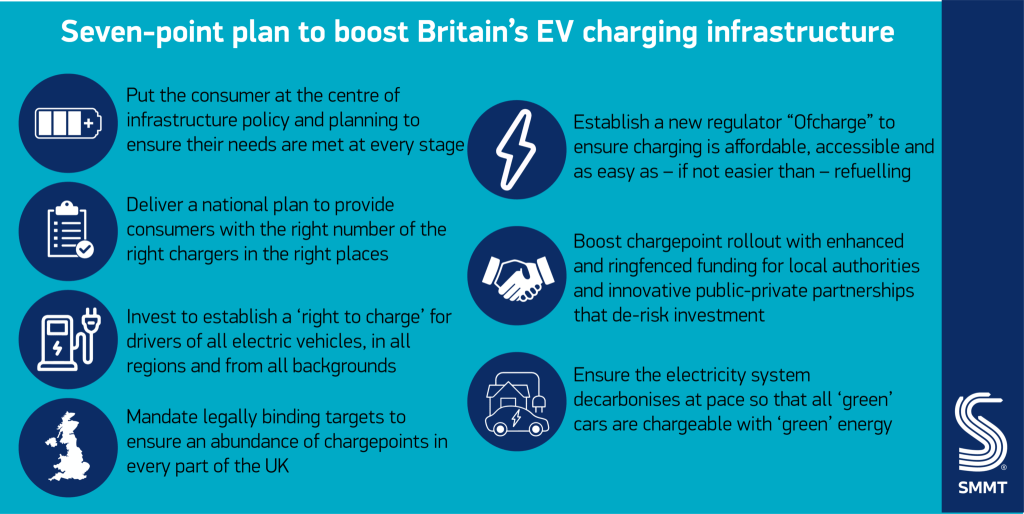The UK automotive industry has today (16 February 2022) called for a new regulatory body to monitor the electric vehicle (EV) market, including charging price levels and affordability.
The new body, ‘Ofcharge’ (the Office of Charging), would help to enforce regulated minimum standards. This would keep the consumer at the heart of infrastructure planning and rollout to ensure every region of the UK is in readiness for the end of sale of new petrol and diesel cars in 2030, with a unified approach bringing together drivers, chargepoint operators, energy companies and local authorities.
The Society of Motor Manufacturers and Traders (SMMT) has also published a new seven-point plan to ensure every driver in Britain can benefit from an EV charging network that is affordable, available and accessible to all. The plan, designed to drive collaboration between government, industry and all other stakeholders, calls for mandated targets for infrastructure rollout, backed by an independent regulator to keep consumers at the heart of planning.
Since 2011, government, local authorities and the charging infrastructure sector have successfully delivered a 3,000% increase in the number of standard public chargepoints, and the UK’s provision of one rapid charger per 32 battery electric vehicles is the best in the Western world, behind only China (1:11), South Korea (1:12) and Japan (1:17).
However, as demand for electric vehicles has surged – accounting for more than one in six new cars in 2021 – standard public charging infrastructure has struggled to keep pace. Plug-in cars on the road grew by a phenomenal 280.3% between 2019 and 2021, but standard chargepoints increased by just 69.8% in the same period. Meanwhile, battery electric cars in the parc rose by a staggering 586.8%, whereas rapid/ ultra-rapid charger stock grew by only 82.3%. This is undermining consumer confidence to make the switch, with range anxiety now replaced by charging anxiety.
Although most current plug-in car users charge at home, public chargers remain critical to consumer confidence and are still relied upon by many commercial fleets, as well as the third of British households that do not have designated off-street parking. Furthermore, drivers face a growing regional divide in chargepoint availability. At the end of 2020, the ratio of electric cars to standard public chargers was 1:37 in the north of England, compared with 1:26 in the south – and in 2021, the ratio deteriorated significantly in the North to 1:52, compared with 1:30 in the south.
To give all drivers the confidence they will be able to charge as easily as they refuel, wherever they live or work, the sector is proposing a nationally coordinated and locally delivered infrastructure plan that puts the needs of consumers first, while also giving chargepoint operators and local authorities certainty to install the right number of the right chargers in the right places ahead of need, across every part of the UK.
With car makers having already invested billions of pounds to bring more than 140 models of plug-in car to market in the UK and 55 more to be launched this year, the SMMT says a guarantee on infrastructure provision will give consumers the confidence to make the switch in even greater numbers.
Mike Hawes, SMMT Chief Executive, said: “The automotive industry is up for the challenge of a zero-emission new car and van market by 2035. Delivering this ambition – an ambition that would put the UK ahead of every major market in the world – needs more than automotive investment. It needs the commensurate commitment of all other stakeholders, especially the charging industry as surveys show that range anxiety has been replaced by charging anxiety.
“Our plan puts the consumer at the heart of this transition, assuring them of the best possible experience backed by an independent regulator. With clear, equivalent targets and support for operators and local authorities that match consumer needs, government can ensure the UK has a chargepoint network that makes electric mobility a reality for all, cutting emissions, driving growth and supporting consumers across the UK.”
Unlocking the full environmental and socio-economic benefits of the transition to zero emission mobility is contingent on collaboration involving industry, government and key sectors, including fleets, infrastructure and energy. If action is taken, SMMT forecasts the new plug-in car market will continue to grow rapidly, resulting in a UK car parc comprising 9.3 million plug-in cars by 2030 (27.0%) and 18.4 million by 2035 (54.8%), of which 6.9 million (20.1%) and 15.3 million (45.6%) respectively are zero- emission, thus ensuring road transport delivers its part in the UK becoming the first major nation to be net zero.
Seven steps to delivering consumer-centric charging infrastructure for zero emission mobility:
- Embed consumer-centricity in policy and a national plan on charging infrastructure
- Develop and implement a nationally coordinated but locally delivered infrastructure plan
- Invest significantly to uplift all types of charging infrastructure, particularly public chargers, ahead of need
- Set binding targets to ensure adequate public chargepoint provision and social equity
- Enact proportionate regulation to deliver the best outcomes for consumer experience and expansion of provision
- Provide adequate enabling support to incentivise and facilitate delivery of charging infrastructure
- Ensure electricity networks are future-proofed and fit for purpose for zero emission mobility
More information at: https://www.smmt.co.uk/wp-content/uploads/sites/2/SMMT-UK-Auto-seven-point-plan-to-boost-Britains-EV-charging-infrastructure.pdf
Image courtesy of SMMT.








